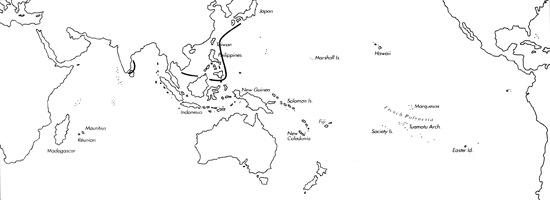Range: C. a. asiaticus: Japan to Philippines and Vietnam, Queensland; C. a. lovellreevei: S. E. India.
Description: Usually medium-sized, moderately solid. Last whorl ventricosely conical, sometimes also conical in C. a. asiaticus (Pl. 46, Figs. 29, 30) and slightly ovate in C a. lovellreevei (Pl. 46, Fig. 31); outline convex adapicall less so below; left side slightly to distinctly concave near base. Siphonal fasciole sometimes very prominent and basal part of columella deflected to left in C. a. asiaticus. Shoulder angulate to carinate. Spire of moderate height, outline concave. Larval shell of 2- 2.5 whorls, maximum diameter 0.7-0.8 mm. First 3-6 postnuclear whorls tuberculate in C. a. asiaticus, first 1-6 in C. a. lovellreevei. Teleoconch sutural ramps nearly flat, with 0-1 increasing to 6-10 spiral grooves in C. a. asiaticus and 5-8 grooves in C. a. lovellreevei. Last whorl with strong, widely spaced major spiral ribs and ribbons, sometimes weakly granulose in C. a. lovellreevei and often strongly granulose in C. a. asiaticus; interspaces with distinct axial striae crossing spiral threads and 1-3 additional minor spiral ribs and/or ribbons.
| Shell Morphometry | ||
|---|---|---|
| L | - | |
| RW | - | |
| RD | - | |
| PMD | - | |
| RSH | - | |
Ground colour white. In C. a. asiaticus, last whorl sparsely to heavily overlaid with light brown axial streaks and blotches, mostly concentrated in adapical half and arranged in 1-2 spiral bands. In C. a. lovellreevei, last whorl usually adapically with sparse brown dots and axial streaks arranged in 1-2 spiral bands. Larval whorls white or grading to beige in C. a. asiaticus, white to brownish beige in C. a. lovellreevei; early postnuclear sutural ramps white to brownish beige in C. a. asiaticus, darker in C. a. lovellreevei. Late ramps with brown radial streaks and blotches, paler in C. a. asiaticus. Aperture white.
Periostracum grey to brownish grey, thin, translucent, smooth.
Habitat and Habits: In 25-60 m.
Discussion: C. asiaticus is similar to C. mucronatus, C. alabaster, C. pagodus, C. sculpturatus, and the typical form of C. sculcatus. C. mucronatus differs in its last whorl pattern with prominent brown spiral lines, its weaker spiral sculpture on the adapical part of the last whorl, and its generally more conical and straight-sided last whorl. C. alabaster has a lower spire (RSH 0.10-0.14) with a more concave outline that is rather flat in the late whorls; the spiral elevations on the last whorl are narrower and the color pattern lacks the brown axial streaks. For comparison with C. sculcatus, C. pagodus, and C. sculpturatus see the DISCUSSION of those species. Because of there disjunct geographic ranges, the slight differences in the shell morphology between C. asiaticus and C. lovellreevei justify seperation at the subspecies level.

C. asiaticus range map
This section contains verbatim reproductions of the accounts of 316 species of Conus from the Indo-Pacific region, from Manual of the Living Conidae, by Röckel, Korn and Kohn (1995). They are reproduced with the kind permission of the present publisher, Conchbooks.
All plates and figures referred to in the text are also in Röckel, Korn & Kohn, 1995. Manual of the Living Conidae Vol. 1: Indo-Pacific Region.
The range maps have been modified so that each species account has it own map, rather than one map that showed the ranges of several species in the original work. This was necessary because each species account is on a separate page on the website and not confined to the order of accounts in the book.